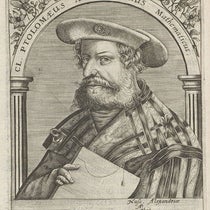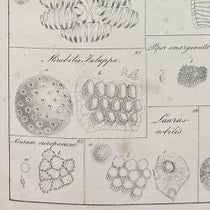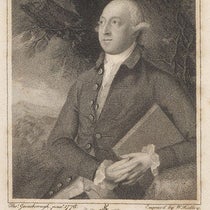Scientist of the Day - Eduard Rüppell
Eduard Rüppell, a German naturalist and explorer, was born on Nov. 20, 1794, in Frankfurt am Main. His father was a wealthy banker, and Eduard seemed destined for the world of commerce until 1817, when he visited Egypt and met Henry Salt and Ludwig Burckhardt, who were busy liberating the Younger Memnon from its sandy resting ground near Thebes and sending it on to the British Museum. He must have met Giovanni Belzoni as well. He returned to Frankfurt, where he joined the newly formed Senckenberg Nature Research Society, even though he had had no training or education yet in natural history.
Eduard learned the rudiments of natural history at several universities in Italy, then returned to the Sinai in 1821 and started collecting and sending back specimens to Frankfurt. He collected everything, it seems – plants, animals, birds, fish, even manuscripts, and did not return to Frankfurt until 1827. In his absence, the Society published an Atlas zu der Reise im nördlichen Afrika (Alas of Travels in North Africa, 1826-28), a folio that we have in our collections, but have not yet scanned, and which contains some of Rüppell’s descriptions and drawings of Red Sea animals and fish.
The Senckenberg Society was pleased with Rüppell’s collecting activities and sent him back to North Africa, this time to Ethiopia, then called Abyssinia, which very few European naturalists had visited. He spent years there, traveling up the Blue Nile, and even visiting the Dahlak Islands in the Red Sea, about 50 miles offshore from Massawa.
After his return to Frankfurt, Rüppell published a folio volume (really four volumes in one) called Neue Wirbelthiere zu der Fauna von Abyssinien (New Vertebrate Fauna of Abyssinia, 1835). Our copy is beautiful – never bound, and kept in a portfolio. The four volumes describe mammals, birds, reptiles and amphibians, and fish, each paginated separately, and at the end of each volume, there are full-page, hand-colored, lithographed plates. The mammals and fish were drawn by Rüppel, and while he did not have the artistic touch of his contemporary Elizabeth Gould, he did well enough, especially with his lively Agama (first image), the Abyssinian genet (fourth image), and the gelada baboon (seventh image), which is found only in the Ethiopian highlands.
Rüppell was a giant of eponymy, which is a fancy way of saying that lots of animals were named after him, such as Rüppell’s agama, Rüppell’s bustard, and Rüppell’s wrasse. I thought about showing his agama or his bustard, but the agama and bustard that he included in his book (first and sixth images) are much more photogenic, so I stuck with them.
I should probably have introduced Rüppell by first discussing the Atlas of 1826-28, his initial publication, before moving on to the 1835 Neue Wirbelthiere, but the Atlas is three times as thick, and because it too is unbound, would have taken a long time to scan. So I started with the shorter book, giving us a year to scan the larger work, before I return to Rüppell. Perhaps in that time I will be able to find out more about the man, who lived to be 90, but whose career after 1840 is a blank to me.
William B. Ashworth, Jr., Consultant for the History of Science, Linda Hall Library and Associate Professor emeritus, Department of History, University of Missouri-Kansas City. Comments or corrections are welcome; please direct to ashworthw@umkc.edu.

![Agama colonorum (Spiny agama), hand-colored lithograph, cropped, Neue Wirbelthiere zu der Fauna von Abyssinien, by Eduard Rüppell, [v. 3] Amphibien, plate 4, 1835 (Linda Hall Library)](https://assets-us-01.kc-usercontent.com:443/9dd25524-761a-000d-d79f-86a5086d4774/42f3e8a2-b691-4d33-abd7-55d0d07fc1be/Ruppel%201.jpg?w=534&h=582&auto=format&q=75&fit=crop)
![Agama colonorum (Spiny agama), hand-colored lithograph, cropped, Neue Wirbelthiere zu der Fauna von Abyssinien, by Eduard Rüppell, [v. 3] Amphibien, plate 4, 1835 (Linda Hall Library)](https://assets-us-01.kc-usercontent.com:443/9dd25524-761a-000d-d79f-86a5086d4774/42f3e8a2-b691-4d33-abd7-55d0d07fc1be/Ruppel%201.jpg?w=775&h=597&auto=format&q=75&fit=crop)
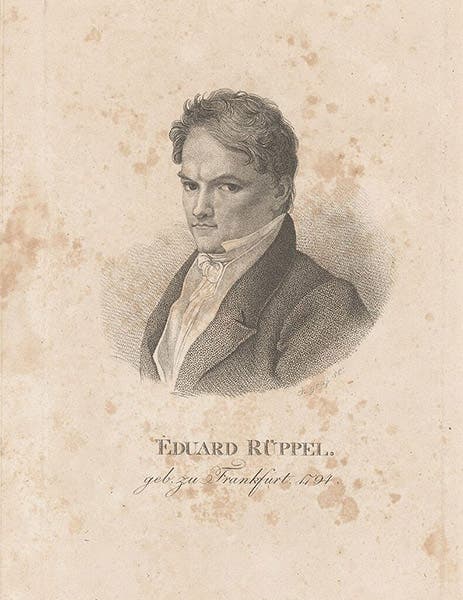
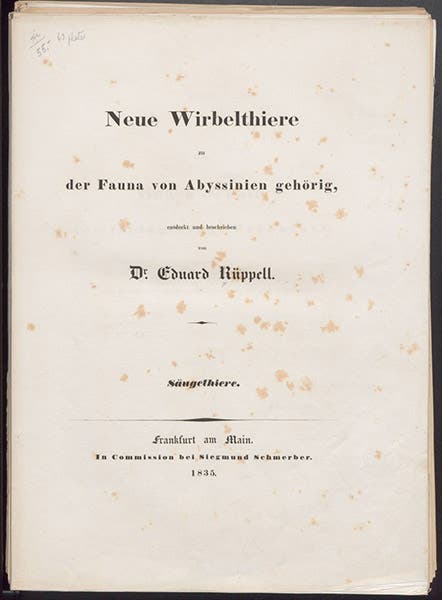
![Viverra abyssinica (Abyssinian genet), hand-colored lithograph, cropped, Neue Wirbelthiere zu der Fauna von Abyssinien, by Eduard Rüppell, [v. 1] Säugethiere, plate 11, 1835 (Linda Hall Library)](https://assets-us-01.kc-usercontent.com:443/9dd25524-761a-000d-d79f-86a5086d4774/cab69ec9-a9e8-4b1a-8da1-ee109f492166/Ruppel%204.jpg?w=775&h=511&auto=format&q=75&fit=crop)
![Detail of fourth image (Abyssinian genet), showing signature of Rüppell, Neue Wirbelthiere zu der Fauna von Abyssinien, by Eduard Rüppell, [v. 1] Säugethiere, plate 11, 1835 (Linda Hall Library)](https://assets-us-01.kc-usercontent.com:443/9dd25524-761a-000d-d79f-86a5086d4774/2c005494-f95c-4dea-808f-5c03bf073af0/Ruppel%205.jpg?w=775&h=478&auto=format&q=75&fit=crop)
![Otis melanogaster (Black-bellied bustard), hand-colored lithograph, uncropped, Neue Wirbelthiere zu der Fauna von Abyssinien, by Eduard Rüppell, [v. 2] Vögel, plate 7, 1835 (Linda Hall Library)](https://assets-us-01.kc-usercontent.com:443/9dd25524-761a-000d-d79f-86a5086d4774/69cc2f2a-f277-4779-bed3-c0b59c369d8f/Ruppel%206.jpg?w=445&h=600&auto=format&q=75&fit=crop)
![Macacus gelada (gelada baboon), hand-colored lithograph, cropped, Neue Wirbelthiere zu der Fauna von Abyssinien, by Eduard Rüppell, [v. 1] Säugethiere, plate 2, 1835 (Linda Hall Library)](https://assets-us-01.kc-usercontent.com:443/9dd25524-761a-000d-d79f-86a5086d4774/b4d42efc-1b1c-47ec-8322-71f5c9948f04/Ruppel%207.jpg?w=775&h=534&auto=format&q=75&fit=crop)
![Ceratta olivacea, (olive ridley sea turtle), hand-colored lithograph, cropped, Neue Wirbelthiere zu der Fauna von Abyssinien, by Eduard Rüppell, [v. 3] Amphibien, plate 4, 1835 (Linda Hall Library)](https://assets-us-01.kc-usercontent.com:443/9dd25524-761a-000d-d79f-86a5086d4774/15f41714-ab2c-4d51-a26b-f841536baaca/Ruppel%208.jpg?w=564&h=600&auto=format&q=75&fit=crop)
